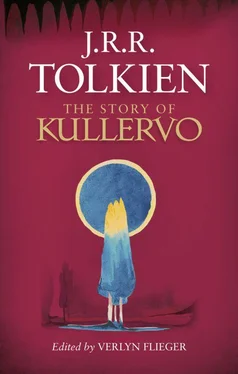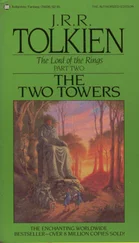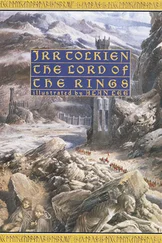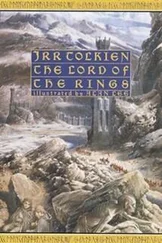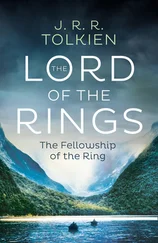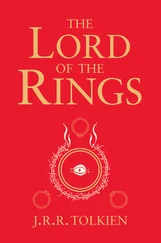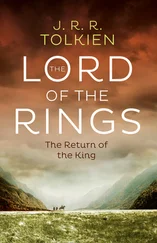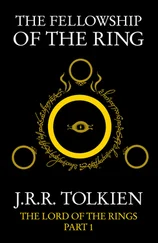The delicious exaggerations of these wild tales could no doubt be learnedly compared to a hundred primitive or modern uncivilized literatures, and collections of legend — but, even if I could, I wouldn’t for the present move outside Europe; for however wild, uncivilized and primitive these things may be their atmosphere and landscape belong essentially to Northern Europe, and to emphasize that I would willingly forgo a hundred parallelisms. It is all the same true that the unrestraint and exaggeration in the Kalevala does at once recall such things as say the Welsh stories of the Mabinogion, and other similar things in Welsh and Irish; but in reality their cases are very different. In the Kalevala there is often no attempt at even the limited plausibility of the fairy-tale, no cunning concealment of the impossible — only the child’s delight in saying that he has cut down a million trees, or that he will knock down some such august personage as his father, if indeed he has not already slain twenty policemen. All this is not intended to take you in, nor even to cast the brief spell of the story-teller’s illusion over you. Its delight depends on the dawning perception of the limits of ordinary human possibility and at the same time of the limitless power of movement and of creation of the human fancy and imagination. Latent in it no doubt is the heroism of the human battles with overmastering fate, and courage undaunted by unconquerable odds — but you do not listen to it on that account, you either like it or despise it as an effort of fresh unsophisticated fancy. Of course in the Welsh tales there is often, indeed continually, in evidence the same delight in a picturesque lie, in a strong breathless flight of fancy; but paradoxically the Welsh tales are both far more absurd and far less so than the Finnish. They are more absurd for they are (when we get them) less fresh than they once were; there is in many places a thick dust of a no longer understood traditionlying on them; strings of names and allusions that no longer have any meaning, that were already nonsense for the bards who related them. Any one who wants to see what I mean has only to look at the catalogue of the heroes of Arthur’s court in the story of Kilhwch and Olwen, or the account of the feats that Kilhwch had to perform for the giant Yspaddaden Penkawrin order to win his daughter Olwen. There is little or nothing of this strange lumber in the Kalevala. On the other hand, the Welsh stories are far less absurd for the pictures painted have far more technique; their colours are cleverly, even marvellously schemed; their figures are cunningly grouped. The fairy-tale’s own plausibility is respected; if a man slays an impossible monster, the story holds firm to its lie. In the Land of Heroes a man may kill a gigantic elk in one line and find it more poetic to call it a she-bear in the next. To elaborate this is perhaps unnecessary; but it might be made the occasion of an attempt to say just what I find the atmosphere of the Kalevala to be — my finding you can correct for yourselves from your own knowledge, or from the extracts that I could wish to read to you until your patience was exhausted, and you felt the appropriateness of the last lines of the Kalevala:
‘Een the waterfall when flowing
Yields no endless stream of water;
Nor does an accomplished singer
Sing till all his knowledge fail him.’
It seems to me that what one feels immediately is that there is no background of literary or artistic tradition. The Mabinogion, for instance, has such a background; it is full of the sense of long years of development and even of decay which has resulted, on the one hand, in the cumbering of the tale with forgotten traditional names and matter, and on the other has produced a field of the most excellently harmonised and subtly varied colours against which the figures of the actors stand out — but they also harmonise with the marvellous surrounding colour-scheme and lose in startlingness if not in clearness. If few have the same intensely vivid feeling for colour that Keltic tales show, yet most similar national legendary literatures have something of this — the Kalevala to me feels to have none. The colours, the deeds, the marvels, the figures of the heroes are all splashed onto a clean bare canvas by a sudden hand; even the legends concerning the origin of the most ancient things in the world seem to come fresh from the singer’s hot imagination of the moment. Certainly there are no modernities in it like trams or guns or aeroplanes; the heroes’ weapons it is true are the so-called antique bow and spear and sword, but at the same time there is a ‘nowness’, a quite unhazy unromantic momentariness and presentness that startles you mightily when you suddenly realize that you are all the time reading about the earth being made out of a teal’s egg, or of the sun and moon being imprisoned in a mountain. All things must be bought at a price and we have purchased the comparat[ive]-consistency and reasonableness of our tales, the clearer crystallisation of our traditions with the loss of this magic and untarnished freshness.
Now as to what is known of the origin of these poems I know little and will not try to tell much more tha[n] I know. Ever since the coming of Väinämöinen and the making of his great harp, the ‘kantele’ fashioned of pike-bone, from what we know of the Finns they have always loved ballads of this sort; and ballads of this sort have been handed on and sung day after day with unending zest from father to son, and from son to grandson down to the present day, when, as the ballads now lament, ‘the songs are songs of bygone ages, hidden words of ancient wisdom, songs which all the children sing not, all beyond men’s comprehension’. The shadow of Sweden and then of Russia has been over the country for many centuries. Petrograd is in Finland. Things are not, it is to be feared, much better now. The remarkable and delightful thing for us, however, is that these ‘songs of bygone ages’ have somehow been preserved without being tinkered with. Sweden finally in the 12th century conquered Finland (or rather the Finns — their land has never had the hard and fast boundaries of the modern European states). Before that there was continual warfare and continual intercourse with the Northerly Germanic peoples that stretches back beyond the beginnings of our era, and in which doubtless the first bearers of the English name in Holstein and the Islands had a good part — but the intercourse goes back even earlier than that far time. By the Swedish conquest, and by the swords of the Teutonic Knights Christianity began slowly to be introduced — in other words the Finns were one of the last acknowledged pagan peoples of Mediaeval Europe. Today the Kalevala and its themes are still practically untouched by this influence, much less affected by it than the mythology of ancient Scandinavia as it appears in the Edda. Except in the story of the virgin Marjatta at the end, in a few references to Jumala or Ukko god of the Heavens, and so forth, even hints at the existence of Christianity are almost entirely absent; of its spirit there is nothing, as any one can see who compares the crude story of Marjatta with Christian faith. To this is of course largely ascribable the interesting primitiveness of the poems, the ‘undergrowth’ character of them, though it is also partly responsible for their minor emotional key, their narrow and parochial view — things that in our present holiday mood are not without attraction. For another seven centuries the ballads have been sung in spite of Sweden, in spite of Russia, and do not ever appear to have been written down at all till Elias Lönnrot in 1835 made a collection of many of them, and published a selection of these. These were all collected in Eastern Finland and are consequently in a dialect different from that that has since come to be the modern literary dialect of Finnish. This Kalevala dialect has come now to be a kind of poetic convention. Lönnröt was not the only collector, but it was to him that it occurred to string a selection into a loosely connected form — as it would seem from the result with no small skill. He it was who called this string the Land of Heroes, or Kalevala from Kaleva the mythological ancestor of all the heroes. It consisted of 25 runos or cantos. This was enlarged with freshly collected material to double the size and published again in 1849, and almost immediately appeared in translations.
Читать дальше
